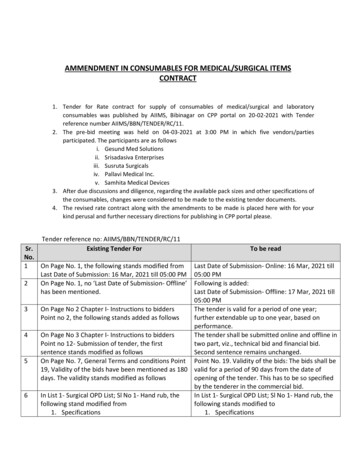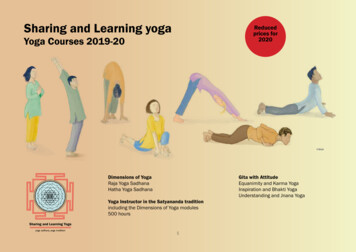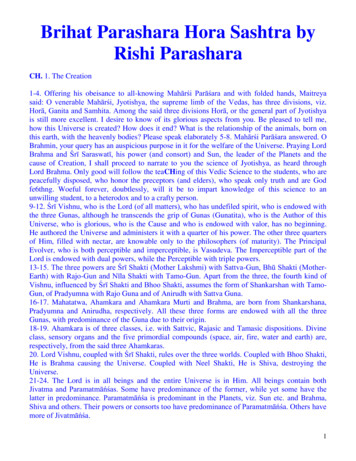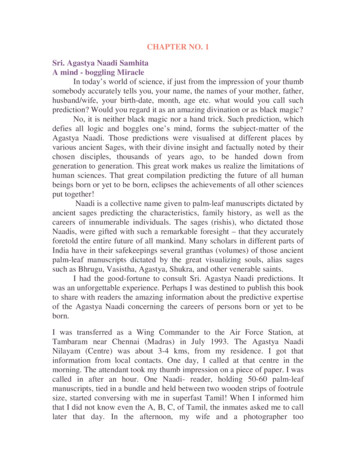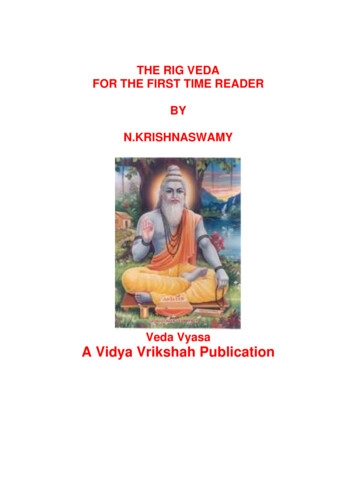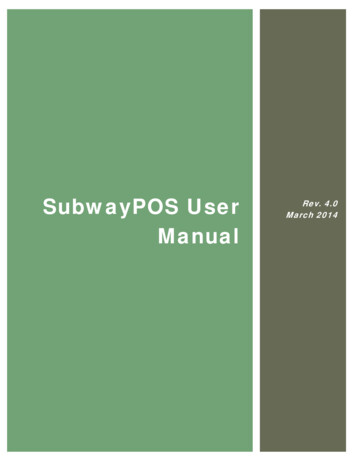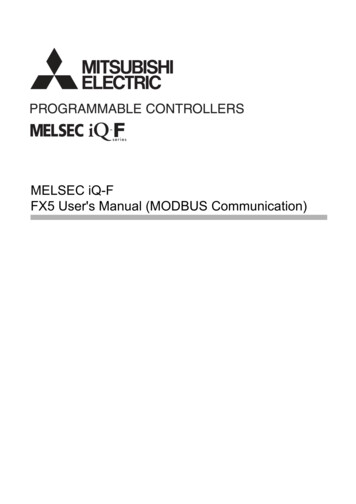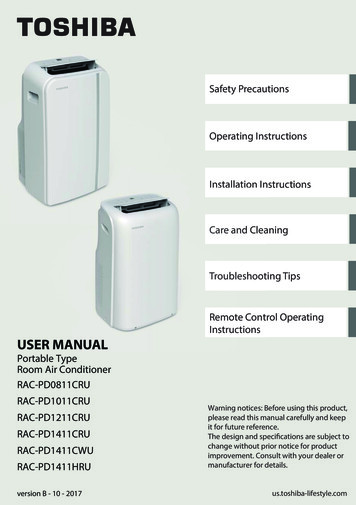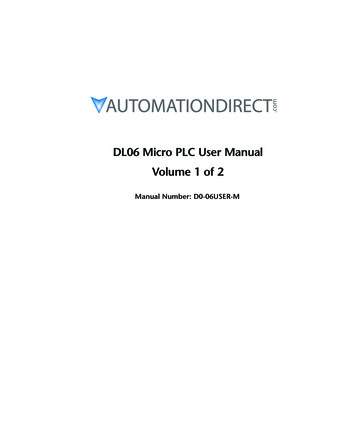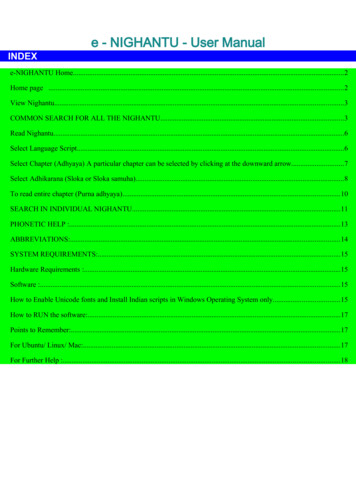
Transcription
e - NIGHANTU - User ManualINDEXe-NIGHANTU Home.2Home page .2View Nighantu.3COMMON SEARCH FOR ALL THE NIGHANTU.3Read Nighantu.6Select Language Script.6Select Chapter (Adhyaya) A particular chapter can be selected by clicking at the downward arrow.7Select Adhikarana (Sloka or Sloka samuha).8To read entire chapter (Purna adhyaya).10SEARCH IN INDIVIDUAL NIGHANTU.11PHONETIC HELP :.13ABBREVIATIONS:.14SYSTEM REQUIREMENTS:.15Hardware Requirements :.15Software :.15How to Enable Unicode fonts and Install Indian scripts in Windows Operating System only.15How to RUN the software:.17Points to Remember:.17For Ubuntu/ Linux/ Mac:.17For Further Help :.18
e-NIGHANTU HomeHome pageHome page gives the information about all the features embedded in the ebook. It displays with the title e-NIGHANTU.Left side menu:Foreword : Foreword by Director General, CCRASPreface : Preface by Director, NIIMHProject Team : Gives the information of the team worked for the preparationof e-NIGHANTUContact Us : Gives the contact informationHorizontal Menu: It has options to browse e-Nighantu home; ViewNighantu; Common Search; Phonetic Help; Abbreviations and Usermanual.
View NighantuBy the clicking on View Nighantu button 25 Nighantu are displayed in according to theAkaradi krama (Alphabetical order).COMMON SEARCH FOR ALL THE NIGHANTUThere is a Common Search button which displays 25 Nighantu. By using this, user cansearch any word in individual Nighantu or in all Nighantus i.e., by selecting our owninterested one or more Nighantu.Any technical term of Ayurveda should be typed in PHONETIC ENGLISH (to know how totype in phonetic english, click Phonetic Help).For example : Here typed dhAnyaka in the search box followed by click Go button willdisplay results.Example : Search for word dhAnyaka – Select 2 or 3 Nighantus and click Go button
Example : Results of selected word dhAnyaka are displayed at the bottom of the web pageExample : Search for word karavIra by the Select of All Nighantu and click Go buttonExample : Results of selected word karavIra are displayed at the bottom of the page
Here user can see the Search results below the page for the selected nighantu. By clicking on any one of the displayed search results the new web page opens. For the example, if clicked on dhanvantarinighantu new web page opens and theresults displayed will be in abbreviated form (- which is in accordance with common practiceof referencing standard Ayurvedic text by scholars) & with hyperlinks.Example : Search for word karavIra - will display 6 results with hyperlinks in the above results, 6 hyperlinks are displayed. ध. नि. . ४ / करवीर ( २ ), mea र ( २ ), means (Dhanvantari Nighantu 4th chapter and 2nd Sloka) Clicking on hyperlink will display the chapter, Adhikarana which includes Sloka of thesearched word in a New Window / Tab. The number of occurrences of the word in Adhikarana will be displayed at the bottom ofthe window.Example : by clicking on ध. नि. . ४ / करवीर ( २ ), mea र ( २ ) - Displays the particular Sloka
Read Nighantu1. To read one among the listed Nighantus, click on particular Nighantu name.2. The new web page, by default displays the selected Nighantu name along with its 1stchapter name (Adhyaya), 1st AdhikaranaNote: By the same procedure user can select, read and search all Nighantu.Note: For example, Bhavaprakasha Nighantu screen shots are displayed.3. Default page displays Bhavaprakash Nighantu 1 chapter (Mishravarga) 1 Adhikaranastst(Vyadhilakshanam of Mulam).Default – Display of Bhavaprakasha Nighantu with chapter name and AdhikaranaSelect Language ScriptA particular Transliteration of the text can be selected by clicking at the downward arrowChoose script here Button at the right top corner, this link provides 9 scripts viz. Devanagari,English Phonetic, Telugu, Kannada, Malayalam, Tamil, Gurmukhi, Bengali and Gujarati. Thisenables to view application in the selected language script.
Select Chapter (Adhyaya) A particular chapter can be selected by clicking at thedownward arrow
Select Adhikarana (Sloka or Sloka samuha)A particular Adhikarana can be selected by clicking at the downward arrowAdhikarana contains either single Sutra or Sutra Samuha (multiple Sutras). Adhikaranacan be in single Sutra or whole Sutra or combining multiple Sutras.Example: Some Adhikarana contains a single Sutra (6)Example: Some Adhikarana contains and multiple Sutras (33-35)
1. Read e-Nighantu(a) One can read Aadhikarana (Sloka samuha) chapter wise through browsing to & fromto previous/ next Adhikarana or(b) Can also read the whole chapter by selecting Purna adhyaya via SelectingAdhikarana menu.(c) By clicking First/ Last button of Select Adhikarana, one can go to first/ last sloka ofthe Adhikarana.To go to next AdhikaranaTo go to Previous AdhikaranaTo go to First Adhikarana
To go to Last AdhikaranaTo read entire chapter (Purna adhyaya)stExample: To read Bhavaprakasha (1 chapter) totallyNote: When Purna adhyaya (entire chapter) is selected for reading - it takes some timeto display, depending on the length of the chapter. Big chapters may take more time,which also depends on your system speed. Hence you are advised not to select PurnaAdhyaya for big chapters unless you definitely require it. If a pop up window arisesasking to stop the script or continue the script - click on continue.2. To read particular Sutra (Sloka) or Sutras - it/they may be viewed in either singleAdhikarana or multiple Adhikarnas based on its/their position/inclusion in single ormultiple Adhikaranas. Sloka number(s) is/are shown in brackets after Adhikarananumber.e.g. (a). बिम्बी (८) m(म्बी (८) meani( (८) meaning 8 Sloka is present in बिम्बी (८) m(म्बी (८) meani( Adhikarana.th(b). साधारण,ध,रणदेश (५-७) me/श (५-७) means from Sloka 5 to Sloka 7 are present in साधारण,ध,रणदेश (५-७) me/शAdhikarana.
Example : To read भा. प्र. नि. हरीतक्,. प. नि. . हर8तक्यादिवर्ग 10-17 sloka, (Bhavaprakas;,दिवर्ग 10-17 sloka, (Bhavaprakasha 3rd cदेश (५-७) meवीर ( २ ), meaर्ग 10-17 sloka, (Bhavaprakasha 3rd chapter 10-17 sloka, (Bhavaprakasha 3rd chapter 10-17Sutra) select 3rd chapter - select Adhikarana (Sloka samkya) : 10-17SEARCH IN INDIVIDUAL NIGHANTU Clicking Search Nighantu button displays the search box. Any technical term of Ayurveda should be typed in PHONETIC ENGLISH. Forknowing how to type in phonetic English click either IN PHONETIC link or PhoneticHelp button which will open a new Window / Tab to show the keyboard. You canselect the script on right hand top corner to view the equivalent phonetic Englishequivalents. Typing a word in search box followed by clicking Go button will display results. Results will display the word in the script selected Results will include all the findings in which the search word is present either singly oras prefix or as suffix or in middle. Results displayed will be in abbreviated form (- which is in accordance with commonpractice of referencing standard Ayurvedic text by scholars) & with a hyperlink.
Example:(1). भा. प्र. नि. हरीतक्,. प. प@. मिश्र. २ / दारुहरिदBश. २ / देश (५-७) me,रुहरिद्रा ( १७५ ) (Bhavaprakasha, Purvरद्रा ( १७५ ) (Bhavaprakasha, Purvardh, ( १७५ ) (Bhavaprakasha, Purvardha, Mishrakadi vargand(2 chapter), 175 Sloka);Clicking hyperlink will display the Adhikarna which includes the searched word in a NewWindow / Tab.For viewing different results click on each to show them in new Window/Tab. One has togo to Search main page to see and click hyperlinks and go to new window to view it inSloka.The number of occurrences of the word in Adhikarana will be displayed at the bottom ofthe window.A few words ideal for search in BhavaprakashaguDUcI (Guduci)va gga (vanga)kA jjika (Kanjika)tuShodaka (Tushodaka)Search for word Guduci (guDUcI) - will display 6 results
Clicking hyperlink will display the Adhikarana which includes the searched word in a NewWindow / Tab.NOTE: To get maximum results (1) try by leaving last letters especially vowels of the search word.(2) try by using minimum of two letters of the search word.(3) try various synonyms of search word.To view results click on results one by one which have hyperlink. New window / Tab willopen to show the result.PHONETIC HELP :Click Phonetic help button, which will open a new Window / Tab to show the keyboard.It helps in understanding the phonetics of Devanagari in turn aids in typing Sanskrittechnical terms.Note: Phonetic help can be seen only in the main page of Nighantu
ABBREVIATIONS:A. GeneralClick on Abbreviations button in e-Nighantu Home page to view abbreviations and theirfull form in a table form.B. Individual NighantuClick on Abbreviations button to view abbreviations and their full form in a table form.
SYSTEM REQUIREMENTS:Hardware Requirements :Pentium IV Processer or Later (or Other Equivalent Processors)CD or DVD DriveMinimum 256 MB RAMBest view in 1024 768 ResolutionSoftware :WindowsXP SP2 or Later with Unicode, Indic & Complex scripts enabled. (See belowfor enabling Unicode)For Ubuntu or Linux or any other OS: (See Below)Better viewed in Mozilla Firefox 3 (potable Firefox is available in the CD). If interestedin viewing in other browsers (Internet Explorer 8 etc) opened browser should be keptopen (i.e. Default Browser window should not be closed)How to Enable Unicode fonts and Install Indian scripts in WindowsOperating System only.(1).Start Control Panel Regional & Language Options Languages Select 'Install files for complex scripts and right to left languages' & Select'Install files for East Asian languages'.
(2). Start Control Panel Regional & Language Options Languages Details Advanced select 'Extend support of advanced text services toall programs' (& Do not Select 'Turn off advanced text services')Note: Both of these require Windows Installation CD. Restart is neededafter installation.
How to RUN the software:1. Insert CD.2. User will be asked to OPT for Running the Application DIRECTLY from CD orINSTALL on the LOCAL MACHINE and RUN.3. While installing on local machine user has to chose the destination path. eg C:\ProgramFiles.4. Once installed on the local machine, the user can run the application without CD.Points to Remember:1. Closing Default opened Browser window will automatically shutdown the server.2. For advanced users & on other Operating Systems : The application uses port 4001 by default. You may change (if necessary) thissetting in the file pms config.ini in the server folder.For Ubuntu/ Linux/ Mac: For OS other than Windows you need to have a working Apache web serverconfigured for PHP, XML. If you already have an Apache server running - you want to host Madhavanidana,put the contents of server/htdocs/Madhavanidana in your web server root. Now theapplication is ready to be viewed on intranet.
For Further Help :DirectorNational Institute of Indian Medical Heritage(formerly known as Indian Institute of History of Medicine)3rd Floor, Osmania Medical CollegePutlibowli, Hyderabad - 500 095Andhra Pradesh, India.Phone :040-24746523Tele Fax : 040-24657388e-Mail :iihm@ap.nic.in; niimh.hyderabad@gmail.comWebsite :http://iihm.ap.nic.in
View Nighantu By the clicking on View Nighantu button 25 Nighantu are displayed in according to the Akaradi krama (Alphabetical order). COMMON SEARCH FOR ALL THE NIGHANTU There is a Common Search button which displays 25 Nighantu. By using this, user can search any word in individua

